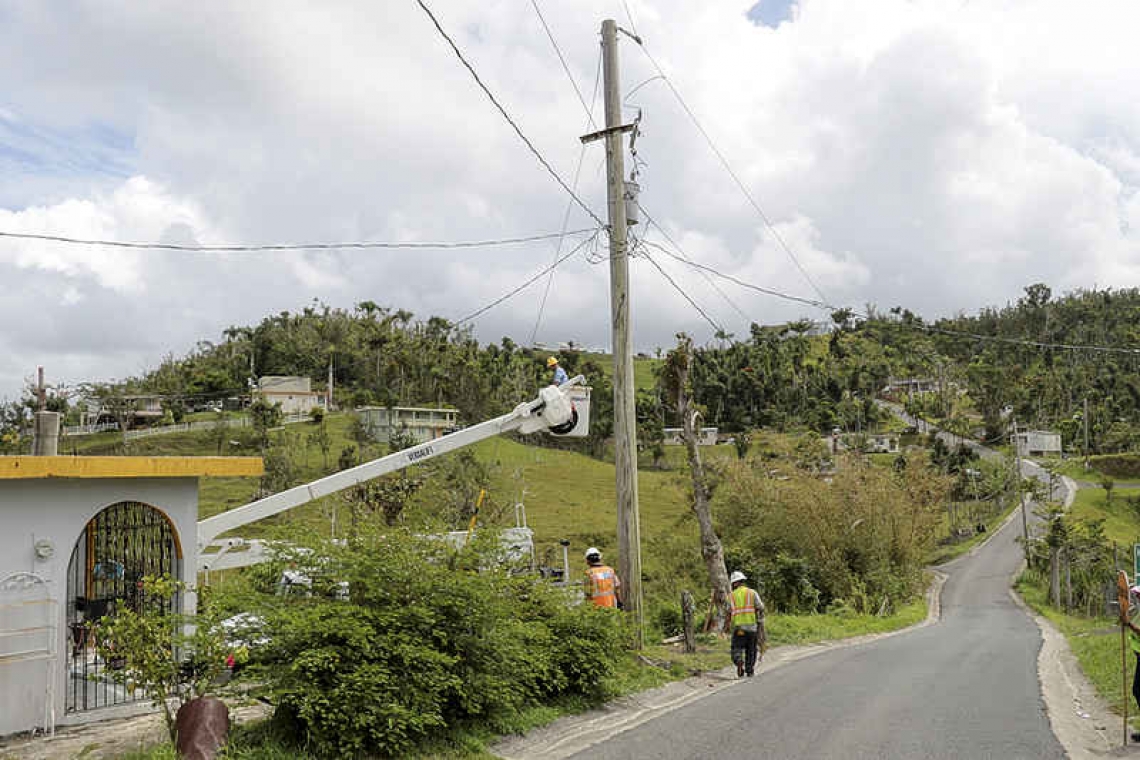US Army Corps of Engineers (USACE) crews work to restore power in Puerto Rico seven months after 2017’s Hurricane Maria. Photo courtesy USACE.
SAN JUAN, Puerto Rico--After facing unreliable electricity since Hurricanes Maria and Irma devastated the island three years ago, Puerto Rico residents finally see a glimmer of hope with its new revised Integrated Resource Plan (IRP), released the last week of August.
Experts say this 20-year plan is better aligned with the territory’s goals of using sustainable, renewable energy and is a step forward for the island after its first plan received major pushback for being too reliant on fossil fuels.
With the US territory’s catastrophic electricity failures, the island has a long road ahead, but the Puerto Rico Electric Power Authority (PREPA) now has the roadmap with the IRP, which has been approved by its regulatory body, the Puerto Rico Energy Bureau.
PREPA’s most recent Chief Executive Officer (CEO) Jose Ortiz resigned in August after outrage over mismanagement of power outages, and the authority is again restructuring its management. Puerto Rico Governor Wanda Vázquez Garced recommended acting CEO Efran Paredes-Maisonet as a permanent CEO. PREPA’s board still needs to approve his appointment.
New plan
The new and aggressive 332-page IRP aims to underground all major transmission lines; diversify, relocate and privatise generation; increase renewable generation; and build out a resilient distribution grid. The plan proposes a contract for 3,900 megawatts (MW) of renewable energy and 1,640MW of battery storage, with no limit on expansion of renewables and storage space.
“I’m happy that they’re making these strong recommendations and making sure that PREPA moves forward [with – Ed.] the right energy solutions for the proper energy transition of the island,” says local Agustín Carbó, who serves as senior manager of micro-grids at the Environmental Defense Fund (EDF), an independent entity that pushes for transparency in Puerto Rico’s energy public policy through ensuring public participation and that information be made public.
The Puerto Rico Energy Bureau, which oversees PREPA, also ordered the authority to directly incorporate use of “mini-grids” into all of its transmission, distribution and resource planning exercises. Mini-grids, an off-grid electricity distribution network involving small-scale forms of generation for remote areas, have been deemed a critical part of the resiliency solutions envisioned for Puerto Rico. The IRP says the island should approve one mini-grid to determine if the concept can function as planned, “including load management, careful vetting of generation options and a design to deliver knowledge and experience relevant to advancing a decentralised renewable energy future.”
“For the Environmental Defense Fund, this is extremely important considering that we are in the process of designing a clean energy system that can provide resiliency to a community in Puerto Rico,” Carbó says. “It’s been tough here. We have a pretty old system that hasn’t been really updated. This is the reason why we have all these outages. We need to think about more decentralised solutions versus centralised.”
Critics of the original IRP, including EDF, complained it didn’t lessen the island’s reliance on fossil fuels. The Sustainable and Alternative Renewable Energy Act, enacted in 2010 and amended in 2019, established a renewable energy portfolio standard in Puerto Rico. The IRP cites the act and how it requires retail energy providers to procure 12 per cent of their power needs through renewable energy by 2015 and 15 per cent by 2020, with a goal of reaching 20 per cent by 2035.
Therefore, the IRP focuses on renewable energy and decentralised clean energy options such as distributed generation, micro-grids, energy efficiency and demand response to meet the renewable portfolio standard and to replace the fossil fuel-generated assets that will be retired, including the AES coal-fired power plant, which will retire by 2027. The distributed generation will also reduce the island’s reliance on electricity that is now brought by transmission lines over its mountainous centre. The IRP also approves a preliminary assessment for a combined cycle gas turbine in the island’s metropolitan area. A budget of US $5 million was approved for limited siting, permitting and feasibility analysis.
“The need for decentralised power generation has been made obvious by multiple hurricanes and earthquakes knocking out concentrated generation on the south shore when [70 per cent] of the people live on the north shore. So that is a no-brainer,” says Stephen Spears, president of Bonneville Contracting & Technology Group LLC, a Puerto Rico-based specialty contractor business concentrating in utilities.
New Fortress Energy has begun construction on a gas port and a generation facility in San Juan, which will serve its Port of San Juan facility, including truck-loading bays. The port will supply liquefied natural gas to the San Juan Combined Cycle Power Plant and encourage on-island industrial, commercial and transportation customers to use this type of more affordable and environmentally friendly energy solution.
“Albeit small, it is a start and it will create more [liquid natural gas] LNG price competition. So that is a good start,” Spears says. “Knocking down existing PREPA-owned plants in the northern Metro area is being discussed ... Selling those properties to private producers seems to be a rational alternative for those old, expensive and antiquated bunker fuel-burning plants.”
If PREPA accepts the changes made by the Puerto Rico Energy Bureau, it will be effective. If not, the authority can appeal the decision. ~ Engineering News-Record ~







